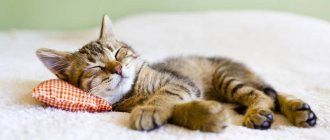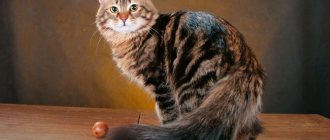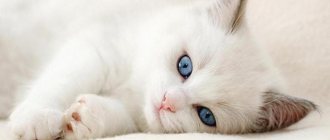Dangerous bacteria
In Australia, an 80-year-old woman died after 9 days in a coma. And, it would seem, there is little extraordinary in such a situation. But a detailed examination revealed that the cause of the coma was the fact that the elderly lady was scratched and licked by her cat. As a result, the woman developed bacterial meningitis, i.e. inflammation of the meninges due to a pathogen of bacterial etiology.
It was the pet that rewarded its owner with the bacterium Pasturella multocida. This pathogen is a rod that is not stable in the external environment and dies when heated or under the influence of ultraviolet radiation. Moreover, such a microbe can survive in soil or manure for 3-4 days.
The infection enters the body through the skin at the site of a bite or scratch left by animals. Inflammation begins in the affected area. But there are also options for hematogenous spread of infection throughout the body.
Protecting yourself from the disease is quite simple in such a situation - you do not need to let animals lick their wounds and other damage to the skin. And if you get a scratch from a claw, you need to treat it with ordinary antiseptics - you can use chlorhexidine or peroxide.
There is no beast more terrible than a cat. Which pets are dangerous for allergy sufferers? Read more
Login to the site
CATS OF PENSION AGE. How to recognize the first signs of aging in your pet
“When the owner is sure that the cat is already old and his life is running out, he is not very surprised if the cat stops eating, becomes dull before his eyes and passes into another world. And then the owner with a pure heart believes that the cat died “of old age.” Experienced amateur cat breeder SESTRATK tells how to correctly determine the age of a domestic cat.
Not everyone knows at what age cats are considered old and how this aging is expressed. I have met people who believed that their cat died of old age at seven years old, but for me these were exceptions rather than the rule. And now I realized that in fact there are quite a lot of people who are not particularly interested in the life milestones of domestic cats. “No one has ever died from old age as a reason.” We will not go into details and clarify why owners may be mistaken about the aging of their animals, but I am sure that these misconceptions are very harmful to cats! After all, when the owner is sure that the cat is already old and his life is running out, he is no longer very surprised if the cat stops eating, grows dim before his eyes and passes into another world. And then the owner with a pure heart believes that the cat died “of old age.” Yes, many people are really sure of this! And what is the surprise and even distrust on the part of these owners when you begin to convince them that, firstly, no one has ever died from old age as a cause (imagine the diagnosis in the pathologist’s epicrisis - “died of old age” - but he will be fired for professional incompetence!), and that seven or even 10 years is not very old age, but the second half of a cat’s active life. Yesterday I learned about another misconception when they count a cat’s years like a dog’s. That is, to understand how old a cat is by human standards, they multiply its age by seven. And this is fundamentally wrong! Not only that, but this is not even true for small dogs! If an animal lives on average up to 16 years, then it is logical to assume that multiplying 16 by seven we get a simply unrealistic human age - 112 years. But cats and small dogs sometimes live up to more than 20 years. What can I say, the oldest cat in the world lived to be 34 years old. Try it, multiply it! These figures actually come from biblical times, when they lived there for 150 years, according to the holy book. “The oldest cat in the world lived to be 34 years old.” How to correctly calculate the age of our cats, how to correctly convert it to human years, and how to determine that a cat is already old? I will try to tell you about this briefly. First, about the calculations. In fact, no one will tell you for sure that, for example, four years is exactly the same as a human 28 years. All calculations are very approximate and vary in different sources. I will write to you about the type of calculation that occurs most often. Up to four years of a cat's life, we use the well-known formula - we multiply the cat's age by seven. So, if a kitten is one year old, then by human standards it is seven years old, if it is three, then it is twenty-one, if it is four, then it is twenty-eight. But then the calculation changes a little. From the fifth to the twelfth year of a cat's life, we will count each year as four human years. And we get the following formula for calculating the age of cats older than four years - 4 * 7 + years of life after 4x * 4 Accordingly, to find out the equivalent of human age for a ten-year-old cat, we calculate using the following formula: 4 * 7 + (10-4) * 4 and we end up with 52 years. It turns out that a 12-year-old cat will already be 60 by human standards. Retirement age. At that time, postman Pechkin’s life was just beginning! “A 15-year-old cat will be, by human standards, a 69-year-old elderly senior.” After a cat turns 12 years old, each cat year is already three human years. That is, a 15-year-old cat will be, by human standards, a 69-year-old elderly senior. And even at this age, he can easily play, catch mice, have fun and enjoy life, of course, if the owners monitor his health and do not brush him off because he is already “old”. I often come across misconceptions caused by feed manufacturers. People argue with me, they say that the old cat is already seven years old! On the package of food it is written - for older cats after seven years. And food producers know better who is elderly and who is not. I will dispel this myth too! The fact is that the term “elderly animal” in Russia is perceived (or translated) somehow incorrectly. Throughout the world, these terms are Kitten - a kitten up to puberty (up to a year), Adult - a transitional age and an adult animal (from one to seven years) and Senior - a middle-aged animal (after seven years). And this distinction by age only tells us that after seven years cats experience another, kind of transitional age, their metabolism becomes somewhat slower, and if at the age of Adult the metabolism could even increase, then at the age of Senior it is slowly starts to slow down. Therefore, at this time we must change food with a high protein content to a lower content and easier digestibility. That's all it means. And not that the cat has already become old and it’s time for him to go to the landfill. By the way, seven years by human standards is 4*7 + 3*4 = 40 years. Come on, my forty-year-old readers, how many of you won’t be offended if they call him grandpa or grandma? “Don’t age young cats” Now about death from old age. I have already mentioned that this strange concept essentially does not exist. Any living being experiences death as a result of injury or failure of one or another organ system, just like that, which I cannot refuse. If the heart stops, there is a reason for it. If pulmonary edema occurs, it means something went wrong. Yes, I don’t argue, there are sudden causes that it seems we couldn’t prevent in any way - for example, blood clots, but in some cases they can be prevented by passing a basic blood test and undergoing a medical examination at the veterinarian (if, for example, a blood clot formed from increased blood clotting and came off from high blood pressure). What I mean is that if you know in advance what risk group your cat is in, what weak organs he has, whether his heart, liver, kidneys... you can always prolong his active life as much as possible. But if you, seeing that at ten years old he became shabby, sad and sleepy, assume that he simply decided to die of old age, then he will die... although he could have lived for many more years if you had taken him to the vet for a couple of months earlier than his gaze glazed over.. In general, do not age young cats, take care of the elderly and undergo medical examination on time!
Source → world weather
Scabies manifestations
Experts note that you can also catch a disease such as scabies from cats. The infection is caused by the mite Sarcoptes scabei. This mite is considered an external parasite of the skin of pets. When the pathogen is transferred to human skin, symptoms such as itching and rash in the form of papules begin to appear. Secondary pustules may appear due to scratching and complications against this background.
Again, banal hygiene decides everything - you need to wash your hands more often after contact with your pet, do not kiss him, give him preventive examinations at the veterinarian on time and give him the necessary vaccinations. Naturally, it is necessary to carry out antiparasitic treatment in a timely manner, which will reduce the risks. And, of course, you should change your pet’s litter box with gloves and thoroughly wash your hands with soap after the procedure.
Aujeszky's disease
This variant of the disease, experts note, is rare. It also has other names - pseudorabies or meningoencephalitis of an infectious nature. The causative agent is the herpes virus. Cats themselves pick up the pathogen when they eat raw meat if the animal was sick. A person receives such a pathogen through the mucous membranes. It is worth remembering that the pathogen is released in the saliva and snot of a sick cat.
After infection with such a pathology, a person may experience the following symptoms: problems with the nervous system in the form of paralysis, itching in the area of the lips, eyes and on the arms and legs, excessive weaving from the nose, increased fearfulness. The pathology is treated with antibiotics and symptomatic therapy, for example taking antipyretics. Moreover, this therapy applies to cats. In humans, everything goes away on its own after 5-7 days. But it’s still better to see a doctor.
Cat and mouse. Can a pet eat caught birds and rodents? More details
Signs of aging
Behavior change
If at a young and mature age the animal was playful and affectionate, but in old age the character became more irritable, then the cat is aging. Older cats receive less pleasure from their owner's affection and stop accepting them. It happens the other way around: old age makes a pet annoying, he constantly pets. The cat’s character traits change; the previously fearless animal becomes frightened by the usual sounds and movements of the owner, becomes nervous, and is cautious.
Decreased activity
As pets age, they prefer to bask in the sun rather than run.
Decreased mobility also indicates age-related changes. Previously, the cat could run around the house all day, play with various objects, and jump on cabinets. Now she moves and meows less, lies more in the sun, sleeps a lot, and does not lead the usual “hunting” lifestyle at night. She has become indifferent to outdoor games and communication, and it is difficult to cheer her up.
Reduced sensitivity
The sensory organs of animals that age react less strongly to external stimuli. Problems arise with hearing, smell, and functioning of the vestibular apparatus. The owners notice changes that manifest themselves as follows:
- The cat does not respond to its name, does not respond.
- Orients himself in space worse.
- Can’t smell food, the cat needs to poke his nose into the bowl for the pet to start eating.
- The hunting instinct disappears.
Deterioration of coat condition
The older an animal gets, the worse its coat begins to look.
It is believed that diseases of old cats are reflected externally. Problems first affect the coat. It fades, hairs fall out, and new ones hardly grow, the animal does not lick itself well, which is why tangles form. The procedures necessary in such cases help little, the cats look bad. Often a pet loses weight - this worsens its appearance, and little can be done in this situation.
Cat scratch disease
This pathology is considered quite well known and quite common. The disease in humans begins due to the entry of the bacterium Bartonella henselae. It is normally found in cats' mouths and is part of the animal's natural microflora. The bacterium enters the human body through licks, scratches, bites and other physical contacts made by the cat. First, a raised red spot appears on the skin - as a rule, it is found at the site of a healed scratch. After a couple of days, it becomes a vesicle with cloudy contents, and then turns into an ulcer. After a maximum of one and a half months, an enlargement of the lymph node closest to the site of the lesion develops.
Additional symptoms include fever, pain in the head, muscles and joints, and decreased appetite. Adults who do not have any chronic diseases recover quickly. Those whose immune systems are not working well may develop complications such as eye infections, as well as heart and brain problems.
How to care for an older cat?
Caring for an older cat is no more difficult than caring for a kitten. You need to be prepared for the fact that the animal will gradually weaken and will require help in performing the simplest daily functions. A few simple tips will help ensure a comfortable old age for your pet.
- Limit your pet's access to the street.
It is strictly forbidden to let an elderly cat out of the house unattended. Even completely healthy animals with perfectly developed reflexes can get hit by a car without having time to dodge the dog’s sharp teeth. An older pet may not notice the impending threat at all.
- Don't forget about regular visits to the veterinarian.
Even if the pet looks completely healthy and behaves quite actively, you cannot refuse preventive visits to the veterinary clinic. The specialist will analyze for hidden infections, prescribe vitamins and preventive treatment.
- Change your pet's diet.
We must not forget that cats are carnivores. To maintain health and a high level of activity, your pet needs to eat protein. Older cats may develop dental problems, so dry food will have to be excluded from the diet. It is better to give the animal wet canned food. If a cat is diagnosed with heart or kidney disease, the owner needs to buy special medicinal food.
Rabies
Of course, one of the most dangerous diseases that pets can transmit is rabies. Moreover, for a person, if the necessary measures are not taken in time, it is fatal. Rabies is characterized by a whole complex of symptoms, one of the most characteristic is hydrophobia, when even when trying to drink ordinary water, a convulsive syndrome develops. In addition, the nervous system suffers greatly, and many systems in the body begin to fail.
The simplest option for such a dangerous and deadly disease is prevention in the form of a vaccine - it is enough to vaccinate the animal against rabies on time to reduce the risks to virtually zero. If a situation occurs where there is contact with a sick animal, a person should consult a doctor as soon as possible and undergo a course of preventive vaccinations that will allow him to save his life.
40 injections in the stomach? Myths and truth about rabies Read more
Safety regulations
It is quite possible to prevent illness from your pet. Simple rules will help prevent infection. The main thing is to visit a doctor with your animal on time, get all the necessary vaccinations, and monitor the animal’s condition. And, of course, it is worth excluding potentially dangerous contacts as much as possible, such as licking wounds - after all, the open surface should not be actively exposed to potentially pathogenic microflora.
You should also wash your hands more often after playing with your pet and before eating or drinking. And, of course, you should not allow the animal to eat from the same plate as the owner. Special attention should be paid to the selection of products and food for your pet - meat should be purchased only from trusted manufacturers, and also monitor the expiration date on food packages. And then the animal owner will not have any health problems.
“No one has ever died from old age as a reason”
We will not go into details and clarify why owners may be mistaken about the aging of their animals, but I am absolutely sure that these misconceptions are very harmful to cats! After all, when the owner is sure that the cat is already old and his life is running out, he is no longer very surprised if the cat stops eating, grows dim before his eyes and passes into another world. And then the owner with a pure heart believes that the cat died “of old age.”
Yes, many people are really sure of this! And what is the surprise and even distrust on the part of these owners when you begin to convince them that, firstly, no one has ever died from old age as a cause (imagine the diagnosis in the pathologist’s epicrisis - “died of old age” - but he will be fired for professional incompetence!), and that seven or even 10 years is not very old age, but the second half of a cat’s active life.
Yesterday I learned about another misconception when they count a cat’s years like a dog’s. That is, to understand how old a cat is by human standards, they multiply its age by seven. And this is fundamentally wrong! Not only that, but this is not even true for small dogs! If an animal lives on average up to 16 years, then it is logical to assume that multiplying 16 by seven we get a simply unrealistic human age - 112 years. But cats and small dogs sometimes live up to more than 20 years. What can I say, the oldest cat in the world lived to be 34 years old. Try it, multiply it! These figures actually come from biblical times, when they lived there for 150 years, according to the holy book.











